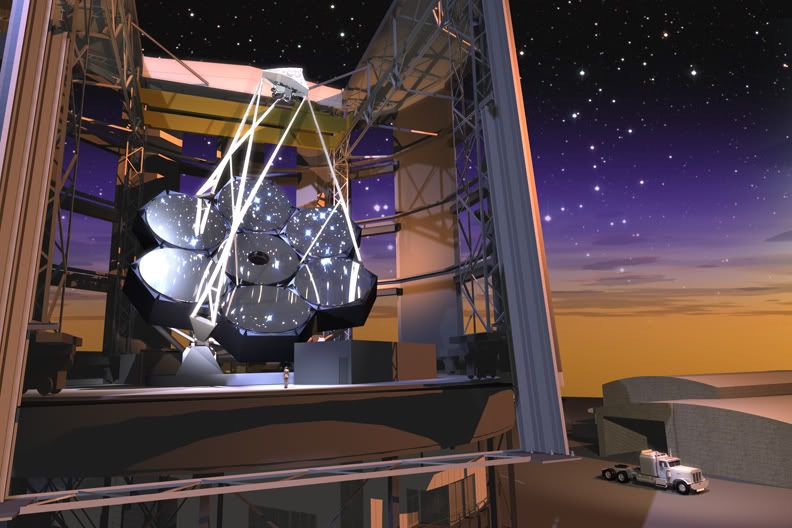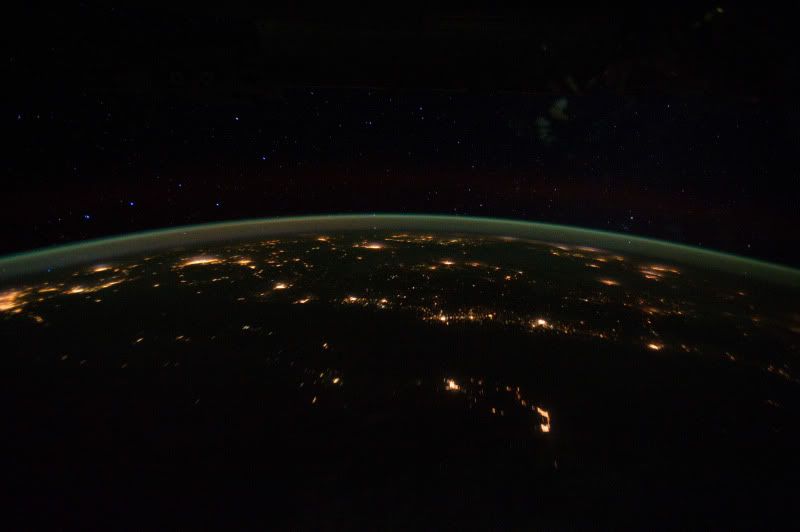Check out this awesome video of Jupiter from the Pic du Midi Observatory in France:
Credit: Jupiter observed with the 1 meter Telescope at the Pic du Midi observatory, and a Basler Scout Camera. Crédit : S2P / IMCCE / OPM / JL Dauvergne / Elie Rousset / Eric Meza / Philippe Tosi / François Colas / Jean Pajus / Xavi Nogués / Emil Kraaikamp
Pretty impressive for even a professional observatory. Perhaps even more impressive is the work being done by Damian Peach with a 14-inch (0.35 meter) telescope. His imaging and movies of Jupiter and the other planets are just as good as the movie above, maybe even better. If you haven't been to his website you should check it out.
We are in a golden age of astro imaging.
Saturday, November 19, 2011
Wednesday, November 16, 2011
Where Big Glass is Born
I recently had the opportunity to tour the University of Arizona's Steward Observatory Mirror Lab. For those not aware the Mirror Lab has cast some truly giant pieces of glass including the primary mirrors for the 3.5-meter WIYN Telescope on Kitt Peak, the 6.5-meter of the MMT Observatory on Mt. Hopkins, the 6.5-meter for each of the two Magellan Telescopes located at Las Campanas Observatory in Chile, and the two 8.4 meter primary mirrors for the Large Binocular Telescope on Mt. Graham.
Each of these large, fast (short focal ratio) mirrors is a product of the Lab's unique strategy of spin-casting glass. A mold is built into the base of a giant oven, glass is then carefully weighed and placed into the mold. The top to the oven is brought over the mold and the entire oven rotates as the glass is melted in place. The oven spins at the proper rate so as to bring the liquid glass into very nearly the curve needed for the telescope's mirror. It continues to spin while the glass slowly cools and anneals.
This is in stark contrast to the old school method to cast the 200-inch (5.1-meter) Palomar mirror back in 1934. There molten glass was ladled into the giant mold (Check out the video here). Once cooled the opticians were given a large, flat disc that then had to have tons of glass removed to produce the necessary curve.
There are currently three mirrors sitting in the lab. The smallest of them is the 6.5 meter that was cast for the San Pedro Mártir Observatory in Baja California, Mexico. As you can see from the short video clip below it is literally hanging around waiting for its chance to get polished.
There are two mirrors already on deck part way through the polishing process in the lab. The first is one of the seven (yes, SEVEN!) mirrors that will make up the Giant Magellan Telescope. The people behind the GMT hope that when it is completed the it will be the first of the next generation of epically large telescopes - a telescope so big that will make the Palomar 200" and even the 10-meter Keck telescopes look small. Here is a visualization of how it will end up looking:
Can you spot the person standing in front of the telescope? That should give you a sense of scale. To bring us back to reality (instead of just concept art) here's a fish-eye shot of me standing in front of the first of the GMT's 8.4 meter mirrors:
Remember, this is just the first of seven 8.4-meter diameter mirrors that will be cast for the project. Here is a short video I shot panning across the span of the mirror:
The second of the seven mirrors will be cast early next year. Between now and then technicians will begin the process of building the mold. They will then weigh and place hunks of glass like this one into the mold:
Here's a video from the University of Arizona featuring Roger Angel, the brains behind the whole spin-casting method, explaining a little bit about the process and the GMT:
Also currently being polished in the Mirror Lab is the 8.4-meter primary mirror for the Large Synoptic Survey Telescope. The LSST will be the world's first wide-angle survey telescope. I believe that the LSST will do more to revolutionize astronomy than any other telescope in existence, under construction or on the drawing boards. From the LSST website:
The mirror was cast to the curve show in the outer portion. To achieve the more steeply curved inner portion of the glass the opticians in the Mirror Lab had to grind it out. I believe to do so, the opticians removed some 5 tons of glass in around 5 weeks.
The unusual shape of the glass proved to be difficult to photograph, but this short video I shot hopefully shows it off:
The tour of the Mirror Lab that I was on was expertly given by Dean Ketelsen (be sure to check out the cool blog that he and his wife write: here). Public tours are available. I recommend them for anyone interested in telescopes or astronomy. After all, the Mirror Lab is the birth place of some of the most productive telescopes working today and coming tomorrow.
Each of these large, fast (short focal ratio) mirrors is a product of the Lab's unique strategy of spin-casting glass. A mold is built into the base of a giant oven, glass is then carefully weighed and placed into the mold. The top to the oven is brought over the mold and the entire oven rotates as the glass is melted in place. The oven spins at the proper rate so as to bring the liquid glass into very nearly the curve needed for the telescope's mirror. It continues to spin while the glass slowly cools and anneals.
 | |
| The Mirror Lab's rotating oven. |
There are currently three mirrors sitting in the lab. The smallest of them is the 6.5 meter that was cast for the San Pedro Mártir Observatory in Baja California, Mexico. As you can see from the short video clip below it is literally hanging around waiting for its chance to get polished.
There are two mirrors already on deck part way through the polishing process in the lab. The first is one of the seven (yes, SEVEN!) mirrors that will make up the Giant Magellan Telescope. The people behind the GMT hope that when it is completed the it will be the first of the next generation of epically large telescopes - a telescope so big that will make the Palomar 200" and even the 10-meter Keck telescopes look small. Here is a visualization of how it will end up looking:
 |
| Credit: GMT, Todd Mason |
 |
| Photo by Mark Lane |
The second of the seven mirrors will be cast early next year. Between now and then technicians will begin the process of building the mold. They will then weigh and place hunks of glass like this one into the mold:
Here's a video from the University of Arizona featuring Roger Angel, the brains behind the whole spin-casting method, explaining a little bit about the process and the GMT:
Also currently being polished in the Mirror Lab is the 8.4-meter primary mirror for the Large Synoptic Survey Telescope. The LSST will be the world's first wide-angle survey telescope. I believe that the LSST will do more to revolutionize astronomy than any other telescope in existence, under construction or on the drawing boards. From the LSST website:
The 8.4-meter LSST will survey the entire visible sky deeply in multiple colors every week with its three-billion pixel digital camera, probing the mysteries of Dark Matter and Dark Energy, and opening a movie-like window on objects that change or move rapidly: exploding supernovae, potentially hazardous near-Earth asteroids, and distant Kuiper Belt Objects.In order to have such a wide-field telescope that can produce sharp images across its field of view, it needs to have a rather complex set of optics. As you can see from the visualization below, even the telescope's primary mirror needs to be fashioned to an unusual shape:
 |
| Credit: LSST, Todd Mason |
The unusual shape of the glass proved to be difficult to photograph, but this short video I shot hopefully shows it off:
The tour of the Mirror Lab that I was on was expertly given by Dean Ketelsen (be sure to check out the cool blog that he and his wife write: here). Public tours are available. I recommend them for anyone interested in telescopes or astronomy. After all, the Mirror Lab is the birth place of some of the most productive telescopes working today and coming tomorrow.
Tuesday, November 15, 2011
2 Videos: The View from Above & The View from Below
Here are two videos for your enjoyment.
First, a visually stunning ride from the International Space Station with aurora, city lights and more:
The second video is far less epic, but maybe just as important. It is a story (with me!) about a revision to the light pollution ordinance in Tucson/Pima County, AZ - one of the few places that is actually trying to control the explosion of light that you can see in the previous video.
First, a visually stunning ride from the International Space Station with aurora, city lights and more:
The second video is far less epic, but maybe just as important. It is a story (with me!) about a revision to the light pollution ordinance in Tucson/Pima County, AZ - one of the few places that is actually trying to control the explosion of light that you can see in the previous video.
Saturday, November 5, 2011
ET & City Lights
 |
| The stars of the Big Dipper (left) and city lights in Baja California, Mexico and the southwest U.S. Image from NASA's The Gateway to Astronaut Photography of Earth |
While I hope that our galaxy is home to other intelligences, I would also like to believe that they would be smart enough to have conquered the problem of light pollution.
A truly advanced civilization would not be afraid of the night as many humans are. Extraterrestrials ahead of us in technology would know that the visible suns of the universe are an inspiration that should not be blotted out. They would hopefully give more thought than humans do in how they light their cities (if they even have cities).
On Earth the vast majority of light at night is a waste. A significant portion of these lights are poorly directed. They shine up and out instead of down where light is needed. Lights illuminate empty streets all night even if they are not in use.
Half of each day is night. Nature depends on night. Humans seem to be trying to change the cycle of day and night even though there is increasing evidence that light at night is not good for our health.
It is time for all of us to be more intelligent about doing a better job in controlling our lights. In the process we will save energy and return the night sky to its natural, star-filled beauty.
Thursday, November 3, 2011
Kitt Peak National Observatory Under Fire
The October issue of NOAO Currents points to some serious funding projections to astronomy that may lead to the closure of Kitt Peak National Observatory (KPNO).
For those unfamiliar, KPNO is a world-class astronomical research facility. While it is not home to the truly giant telescopes of our era, it is a workhorse of modern astronomy. It has numerous telescopes including the 3.5-meter WIYN and the 4-meter Mayall. Work done there increases our basic understanding of the universe, supports the education of young astronomers, advances technology and, through its wonderful public outreach programs, helps to inspire and educate our youth.
Closing this important facility would not only be a major blow to astronomy in the United States, but it would also be a huge drain on the economy of Arizona. A 2008 report found that astronomy has an annual $250 million economic impact for Arizona. Closing KPNO and the National Optical Astronomy Observatory (NOAO) headquarters in Tucson would remove many high paying jobs from this clean industry and also draw away important tourism dollars that the observatory and its outreach programs bring to the state.
It is a shame that cutting budgets and lowering taxes seems to be the only priority of our elected officials. They show a profound lack of understanding of how basic scientific research makes America stronger and more competitive on the world stage.
For those unfamiliar, KPNO is a world-class astronomical research facility. While it is not home to the truly giant telescopes of our era, it is a workhorse of modern astronomy. It has numerous telescopes including the 3.5-meter WIYN and the 4-meter Mayall. Work done there increases our basic understanding of the universe, supports the education of young astronomers, advances technology and, through its wonderful public outreach programs, helps to inspire and educate our youth.
Closing this important facility would not only be a major blow to astronomy in the United States, but it would also be a huge drain on the economy of Arizona. A 2008 report found that astronomy has an annual $250 million economic impact for Arizona. Closing KPNO and the National Optical Astronomy Observatory (NOAO) headquarters in Tucson would remove many high paying jobs from this clean industry and also draw away important tourism dollars that the observatory and its outreach programs bring to the state.
It is a shame that cutting budgets and lowering taxes seems to be the only priority of our elected officials. They show a profound lack of understanding of how basic scientific research makes America stronger and more competitive on the world stage.
Subscribe to:
Posts (Atom)



